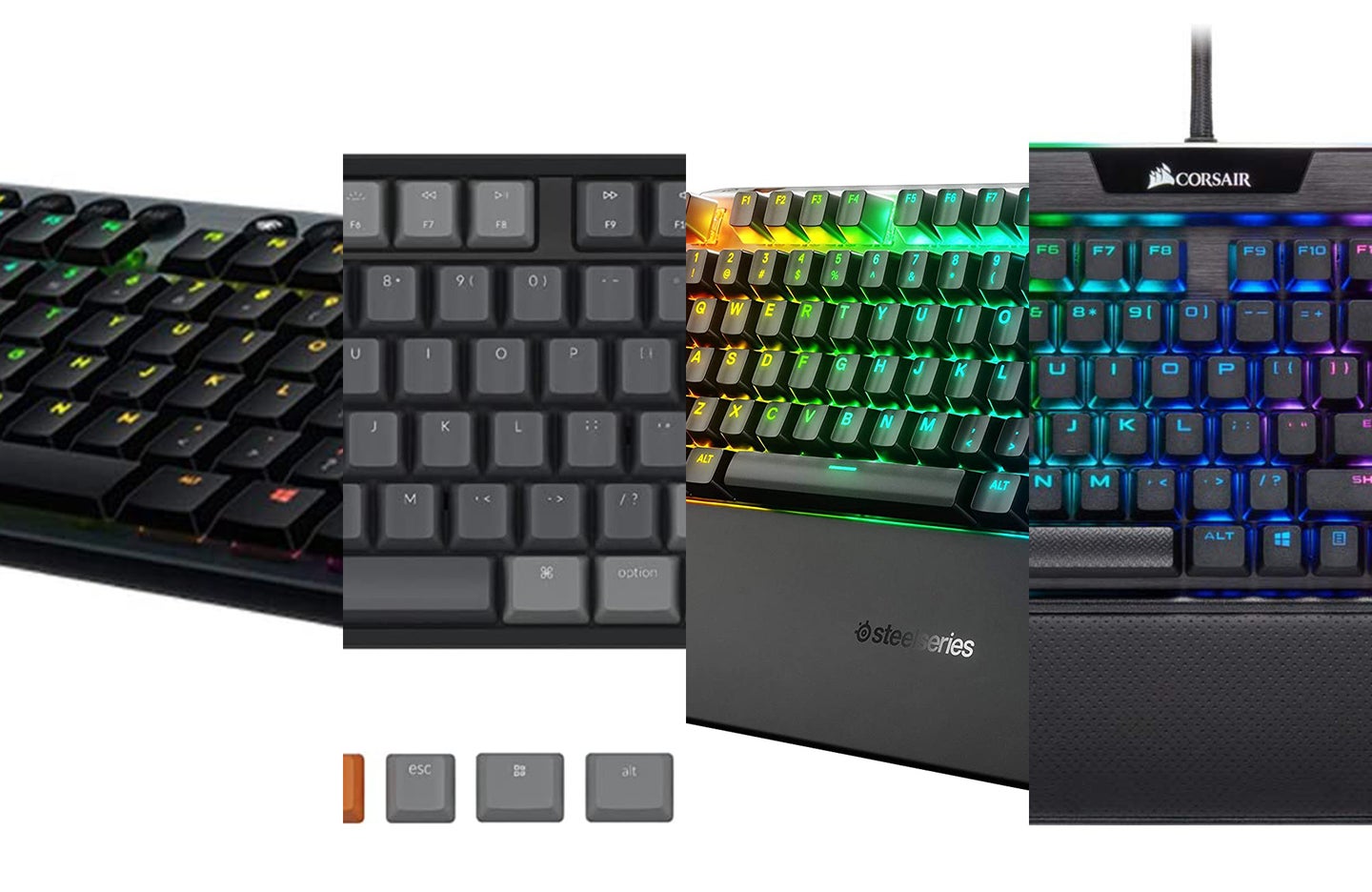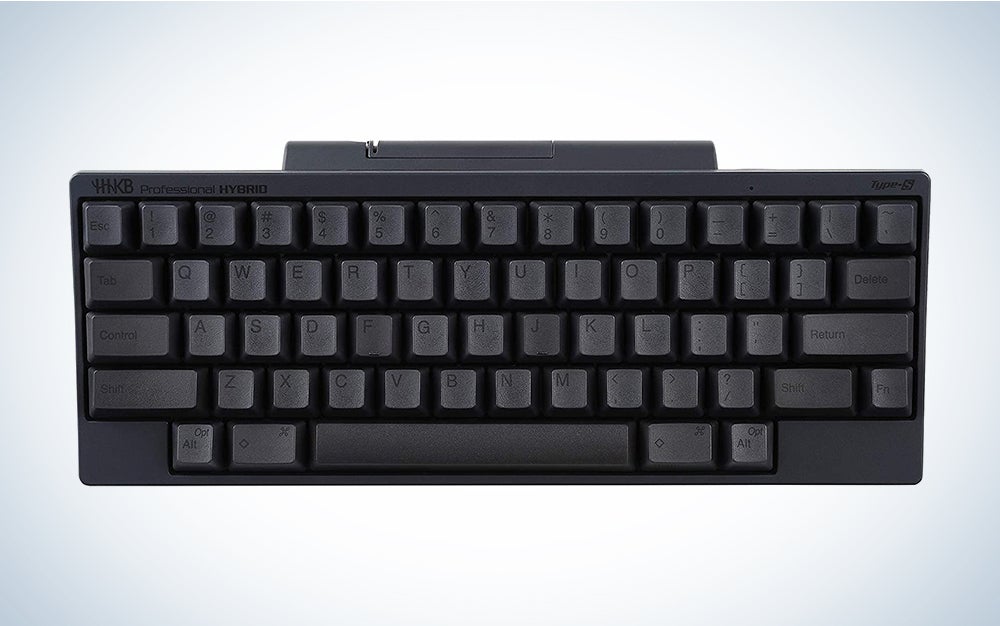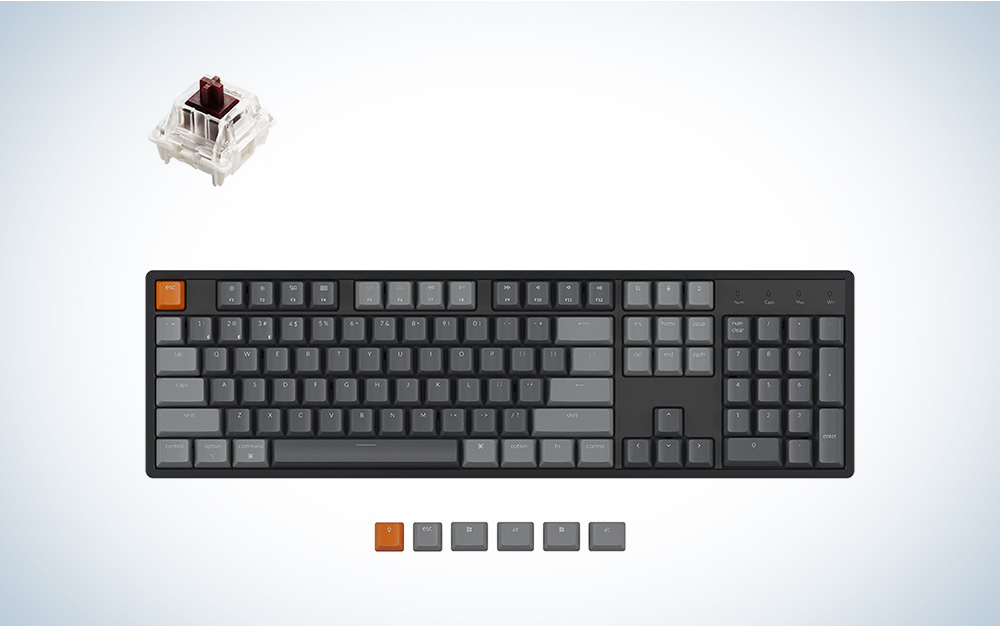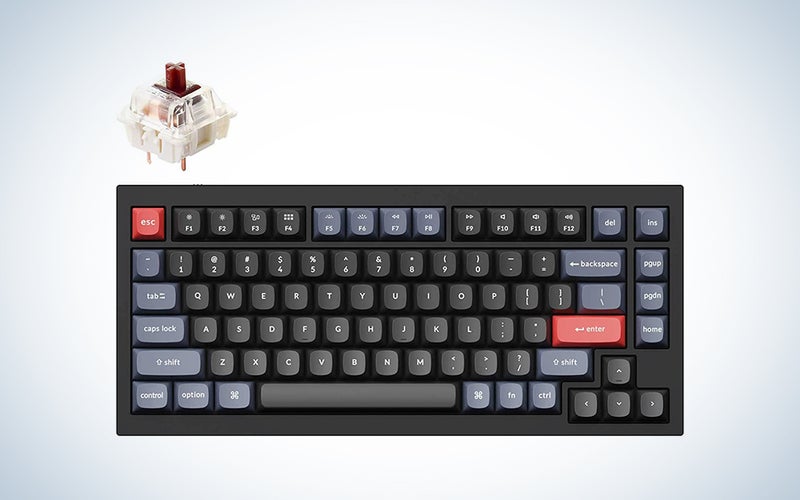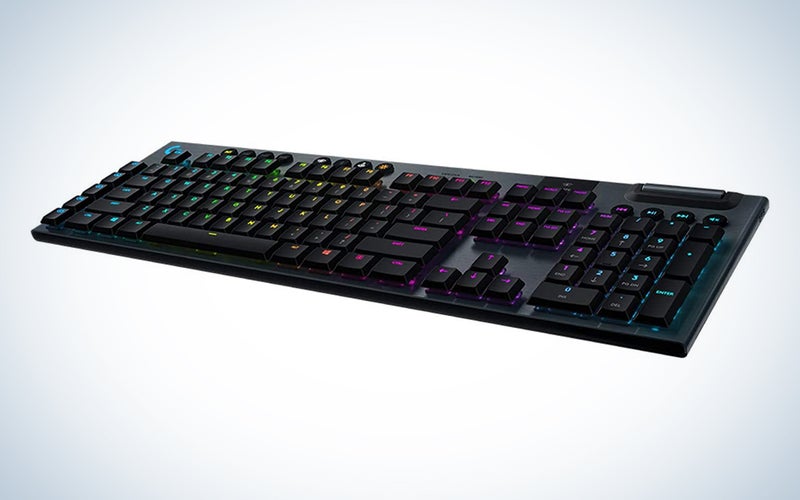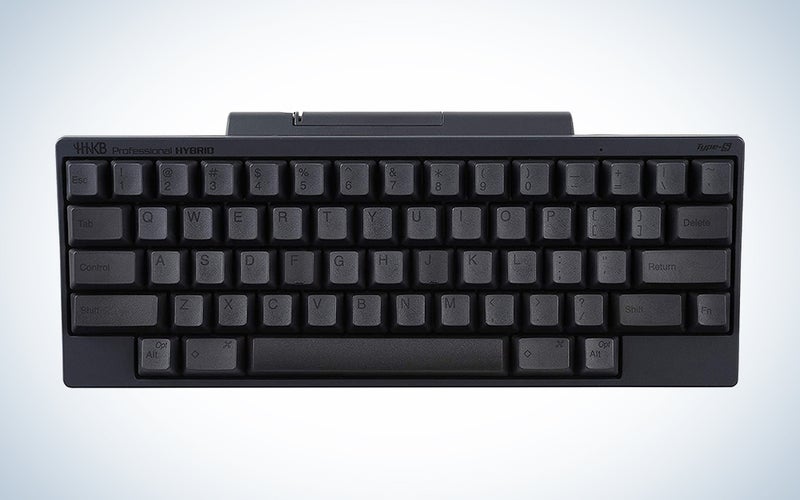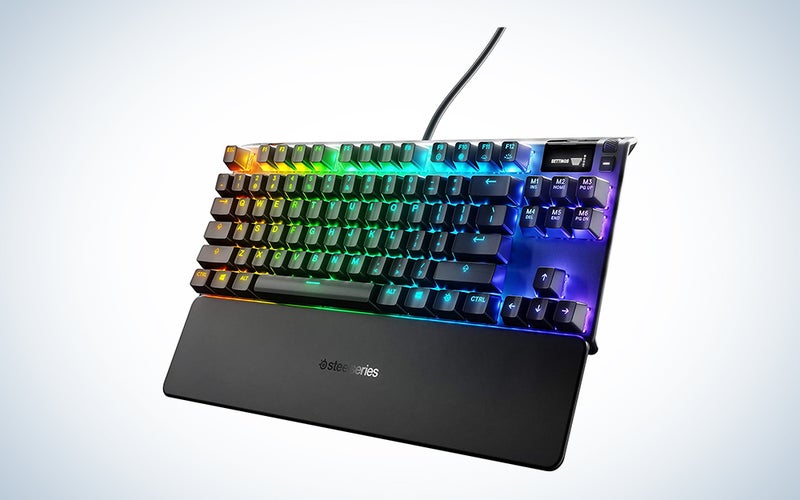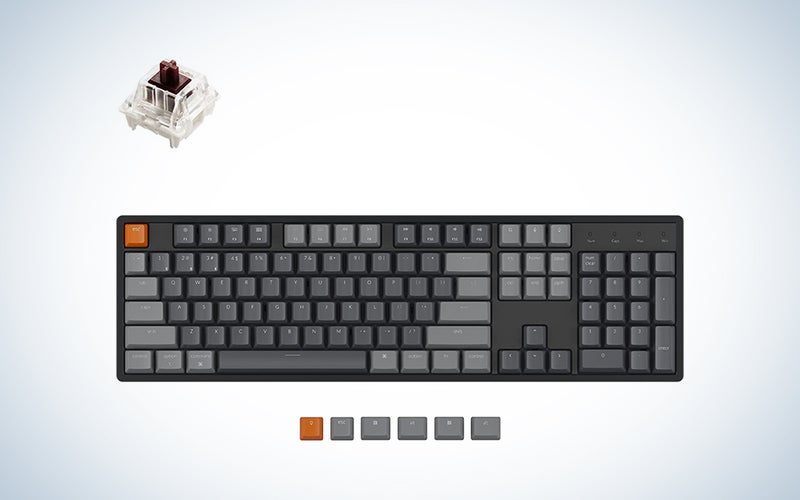We may earn revenue from the products available on this page and participate in affiliate programs. Learn more ›
More and more people are taking an interest in mechanical keyboards. These more expensive, but more satisfying keyboards manually trigger each input using a physical switch under each key. The feeling of pressing a key and feeling the bump of the key “actuating,” or activating the mechanism in the keyboard, makes the typing experience more ergonomic and, dare we say, more pleasurable. If you work from home, go to school, or otherwise spend a lot of time on your computer, a pleasurable typing experience goes a long way. The best mechanical keyboards span a wide range of styles and typing feels, so anyone can find something to fit their taste.
- Best overall: Keychron Q1 (V2)
- Best for gaming: Corsair K95 RGB Platinum XT
- Best wireless: Logitech G915 Lightspeed
- Best for Mac: Das Keyboard MacTigr
- Best for typing: Happy Hacking Hybrid Type-S
- Best TKL: SteelSeries Apex 7 TKL
- Best budget: Keychron K10
How we chose the best mechanical keyboards
As a reporter on technology and gaming beats, I spend a lot of time typing on a keyboard. It’s one of the most important tools for both my productivity and downtime. I’ve covered computing and, more specifically, written about keyboards for Lifewire, Popular Mechanics, and here at Popular Science.
To select our recommendations, we relied on a mix of my experience and the collective expertise of the PopSci team, alongside critical reviews from across the web. We evaluated a wide array of keyboards on a variety of qualities including design, comfort, connectivity, software, build options, and, most importantly, typing feel. Though there are a large number of “barebones” kits and means of building custom keyboards, this list focuses exclusively on pre-built designs from international manufacturers.
What to consider when buying the best mechanical keyboards
Mechanical keyboards can range dramatically in size, price, and functionality. The wide variety of components and specs can easily overwhelm new shoppers. It doesn’t help that custom keyboard design, which has grown trendy over the last few years, can get extremely technical. If you’re new to mechanical keyboards and just want to pick one out and get typing, we have some advice on how to find the right one for you.
What will you use your keyboard for?
Different size keyboards may add or remove certain keys, so take stock of what parts of the keyboard you use regularly. Many people don’t need a full-size keyboard, because they don’t need the number pad on the far right, but you might want it if you work with numbers often. A smaller wireless keyboard is best suited to travelers who need something portable. Anyone with wrist sensitivity might enjoy a specially shaped ergonomic keyboard. Think about what you need from your keyboard, and pick the one best fits your lifestyle.
How do you want your keyboard to feel and sound?
The feel of a mechanical keyboard can vary quite a bit, depending on what kind of switches it has under the keycaps. Switches come in dozens of different styles, which feel different based on the amount of force required to press them down, and their “travel,” which measures how far your finger moves when you press a key down. (Generally speaking, more travel gives your fingers more room to push down, which feels better, even if it means you type less quickly.) Enthusiast keyboard fans also care about how a keyboard sounds: The distinctive clack of a mechanical keyboard is loud, and many consider it soothing.
When you start building keyboards, you’ll find that there’s a whole world of switches to choose from. When buying a model from a major manufacturer, switches generally come in three flavors: “Linear” (often labeled “red”) switches have a very light touch, which is great for gaming, but may lead you to make more typing mistakes. Tactile (or “brown”) switches are defined by their noticeable “bump,” which you can feel when you press them down. Lastly, clicky (or “blue”) switches are especially loud. There’s no telling which you’ll prefer without trying them for yourself, but we recommend starting with tactile switches if you don’t have the ability to compare and contrast at your local electronics retailer.
Wired or wireless?
For most computing tasks, a wireless keyboard provides a comfortable, clutter-free experience that’s easily adjustable. More intense applications, such as gaming and content production, may benefit from a wired keyboard.
Wireless keyboards, especially ones that connect over Bluetooth, introduce a small amount of lag or latency. For most people, this lag will be imperceivable. You may notice it, however, in tasks that require precise timing, such as gaming or audio production.
Gaming keyboard manufacturers in particular often offer a middle-ground between wired and Bluetooth connectivity: A 2.4GHz wireless connection enabled with a USB dongle. We generally recommend using this option if it’s available, though Bluetooth is fine for typing and everyday computing.
First-time users may face an adjustment period
Switching to a mechanical keyboard can be awkward, especially for people used to thin and light laptops and Apple keyboards. You will type slower than you usually do, and may tap each key harder or softer than you need to. It’s completely normal if typing on a mechanical keyboard feels funny at first. We recommend giving at least a couple of weeks to get used to the new feel.
The best mechanical keyboards: Reviews & Recommendations
Keeping all of that in mind, we’ve put together a list of the best mechanical keyboards you can buy right now. Each of our recommendations offers a great typing experience and practical added features. Many of our recommendations offer different sizes and key switches to choose from, so you can pick your preferred version before hitting “add to cart.”
Best overall: Keychron Q1 (V2)
Keychron
Buy it used or refurbished here: eBay
Why it made the cut: A superb out-of-the-box experience leads to a world of customization options for novices and enthusiasts alike.
Specs
- Layout: 75% (82 keys)
- Dimensions: 12.9 x 5.7 x 1.4 inches (WDH)
- Switches: Linear, clicky, tactile
- Keycaps: Doubleshot PBT
- Interface: USB-C
- Backlight: Yes, programmable RGB
- Software: VIA, QMK
Pros
- Excellent type feel
- Physical and digital customization
- Physical Windows/Mac switch, plus keycaps
Cons
- Heavy
The Keychron Q1 (V2) is a premium mechanical keyboard that offers everything casual and enthusiast users could want. It is perfectly capable as a plug-and-play keyboard and can be matched to your tastes with approachable physical and digital customization.
Out of the box, the heavy Keychron Q1 feels superb to type on. The durable keycaps, smooth switches and high-quality stabilizers work in tandem to deliver a supremely comfortable typing experience. The Keychron Q1 is also surprisingly quiet for a metal keyboard. Inside the case, a gasket-mounted design and sound-dampening foam add flexibility and “give” that help to eliminate the metallic pinging sounds commonly associated with heavy metal keyboards.
This keyboard is physically and digitally customizable. Physically, you can swap out the keycaps, key switches, and more, trying out different options until you find your favorite. Digitally, you can download VIA or QMK software to map key inputs, change the RGB lighting, and more. The software takes some getting used to—tutorials by Keychron and other users help to make sense of the more technical parts.
Customization, approachability, and an incredible typing feel put the Keychron Q1 (V2) above the competition.
Best for gaming: Corsair K95 RGB Platinum XT
Cosair
Buy it used or refurbished here: eBay
Why it made the cut: This full-size gaming juggernaut has tons of features that enable extra control in any activity.
Specs
- Layout: Full size (110 keys)
- Dimensions: 18.3 x 6.6 x 1.5 inches (WDH)
- Switches: Linear (Speed silver), clicky, tactile
- Keycaps: Doubleshot PBT
- Interface: Built-in USB 3.1
- Backlight: Yes, programmable RGB
- Software: Corsair iCUE
Pros
- Improved keycaps and wrist rest
- Dedicated media controls
- Six programmable macro keys
Cons
- Limited software with Mac and Linux
Almost a complete 180 from the compact design of the Keychron Q1 is the Corsair K95 RGB Platinum XT, a gargantuan gaming keyboard with tons of bells and whistles. Gamers and programmers who enjoy software customization will find a lot to love in this device.
This full-size design features six extra “macro” keys on the left side. When using supported software, you can customize these keys to do anything from throwing a grenade in Halo Infinite to controlling aspects of your livestream. Dedicated multimedia keys add even more control options.
Typing, gaming, and browsing on this keyboard feel great thanks to subtle improvements over its predecessor. The keycaps are more durable and the wrist rest is more padded, creating less discomfort during long gaming sessions. While this keyboard doesn’t have some of the newest hardware seen in its successor, the K100, its availability and lower price make it one of our favorite gaming keyboards.
Best wireless: Logitech G915 Lightspeed
Logitech
Buy it used and refurbished here: eBay
Why it made the cut: Three modes of connectivity and robust software make this keyboard a portable productivity machine.
Specs
- Layout: Full size (104 keys)
- Dimensions: 18.7 x 5.9 x 0.9 inches (WDH)
- Switches: Low-profile linear, clicky, tactile
- Keycaps: Doubleshot ABS
- Interface: Micro-USB, 2.4GHz RF Wireless, Bluetooth
- Backlight: Yes, programmable RGB
- Software: Logitech G Hub
Pros
- Low-profile switches
- Nearly lag-free wireless
- 30-hour battery life
Cons
- Expensive
Anyone hesitant to make the switch from a laptop to a mechanical keyboard should try the Logitech G915 Lightspeed. It’s a premium wireless keyboard with a thin design that feels familiar to a laptop but is improved in nearly every way.
The G915 is a low-profile keyboard, meaning it has less “travel” distance between an upright and a pressed key position. Despite this laptop-like travel distance, the G915 features high-quality mechanical key switches that are comfortable and satisfying to type on. Add robust software, five macro keys, three profile buttons, multi-media controls, and a volume wheel, and the G915 is one of the most functional keyboards for its size.
Connectivity is a big part of that functionality. The G915 connects via micro-USB, RF wireless dongle, or Bluetooth. Being able to connect in such a variety of different ways makes this one of the most flexible keyboards on our list. Users looking for extra portability should consider the G915’s TKL version, which ditches the number pad to reduce its desk footprint.
Best for Mac: Das Keyboard MacTigr
Das Keyboard
Why it made the cut: The MacTigr offers suburb build quality and an excellent type feel in a Mac keyboard layout.
Specs
- Layout: Full size (105 keys)
- Dimensions: 17.2 x 5 x 1.06 inches (WDH)
- Switches: Low-profile linear
- Keycaps: Doubleshot PBT
- Interface: USB-C
- Backlight: None
- Software: N/A
Pros
- Superb build quality
- Low-profile type feel
- USB-C hub
Cons
- Pricey
There are lots of mechanical keyboards out there, but there aren’t that many made specifically for Macs, with an Apple key in the bottom row. Das Keyboard’s MacTigr is one of the few, and it gives macOS users a polished mechanical keyboard experience without compromise.
It starts with a premium all-metal build, using an aluminum body with a steel plate that will feel familiar to MacBook enthusiasts. Two USB-C ports offer connectivity and charging for your mouse, phone, and more. Media keys, a sleep button, and a volume knob give you convenient control over your work and entertainment.
The keys themselves combine the precision and tactility of a mechanical switch with the shorter key travel time Mac users are used to. Keys feature Mac-specific commands that blend right in with any Mac Studio workstation.
The only major omission, especially at this price range, is backlighting and software. If you don’t mind that omission, this is one of the best keyboards for Mac.
Best for typing: Happy Hacking Hybrid Type-S
Happy Hacking
Buy it used or refurbished here: eBay
Why it made the cut: Minimal and lightweight, the Hybrid Type-S combines Bluetooth convenience with phenomenal Topre key switches to create an ideal typing tool.
Specs
- Layout: 60 percent (60 keys)
- Dimensions: 11.6 x 4.7 x 1.6 inches (WDH)
- Switches: Topre (Electrostatic Capacitive)
- Keycaps: Dye-sublimation PBT
- Interface: USB-C, Bluetooth 4.2LE
- Backlight: None
- Software: N/A
Pros
- Unique Topre key switches
- Wired and multipoint Bluetooth connectivity
- Lightweight and portable
Cons
- Very expensive
- Relies on AA batteries
The Japanese brand Happy Hacking, a subsidiary of electronics giant Fujitsu, has a cult following among enthusiast keyboard fans. The Hybrid Type-S is one of its best—a compact, minimalist keyboard that connects via USB-C or Bluetooth multipoint.
Like all Happy Hacking keyboards, the Hybrid Type-S utilizes uniquely excellent Topre key switches. Topre switches are electro-capacitive, blending elements from mechanical and membrane switches. This creates a lightweight, tactile, quiet feel that is unique to Topre.
Also unique to the Type-S is an alternative key layout. Keys like Caps Lock, Delete, and Backspace are in locations more suited for programming. This alternate layout takes getting used to but makes sense after a few weeks.
The Hybrid Type-S can connect wired or via Bluetooth with up to four different devices. It offers up to three months of battery life via two AA batteries. The biggest thing holding it back from mainstream appeal is its price: Imported switches don’t come cheap.
Best TKL: SteelSeries Apex 7 TKL
SteelSeries
Buy it used or refurbished here: eBay
Why it made the cut: The SteelSeries Apex 7 TKL offers all the bells and whistles of a flagship gaming keyboard in a compact and comfortable package.
Specs
- Layout: TKL (84 keys)
- Dimensions: 14 x 5.5 x 1.6 inches (WDH)
- Switches: Linear, clicky, tactile
- Keycaps: Doubleshot ABS
- Interface: Built-in USB
- Backlight: Yes, programmable RGB
- Software: SteelSeries Engine
Pros
- Compact TKL design
- Excellent software
- Unique OLED mini-display
Cons
- Non-detachable cable
The compact SteelSeries Apex 7 TKL creates a more ergonomic experience than many full-sized keyboards by freeing up desk space and putting your mouse hand closer to your typing space. This can reduce wrist and shoulder strain during long sessions.
The Apex 7 TKL offers solid build quality and a comfortable typing experience, but where it stands out is software customization. The SteelSeries Engine software is approachable and robust. With it, you can control everything from individual RGB backlighting to custom macros. Its most unique application is the small OLED display built into the top right of the keyboard. This screen can be programmed to change settings and profiles, or display custom information like Discord messages and Spotify tracks. Fans of customization and compact keyboards should give the Apex 7 TKL a serious look.
Best budget: Keychron K10
Keychron
Buy it used or refurbished here: eBay
Why it made the cut: The Keychron K10 offers wired and Bluetooth connectivity, a solid type feel, and an affordable price tag.
Specs
- Layout: Full size (104 keys)
- Dimensions: 17.1 x 4.7 x 1.5 inches (WDH)
- Switches: Linear, clicky, tactile
- Keycaps: ABS
- Interface: USB-C, Bluetooth 5.1
- Backlight: Yes, adjustable RGB
- Software: N/A
Pros
- Wired and multipoint Bluetooth
- Windows and Mac compatibility
- Great value
Cons
- No first-party configuration software
The Keychron K10 is an extremely rare keyboard that offers solid wired and Bluetooth connectivity and a great price.
For around $100, the Keychron K10 offers wired USB-C and multipoint Bluetooth 5.1 connectivity. That alone makes it worth the price of entry. Thankfully, the K10 offers other great features. A switch on the left side of the board changes between Windows and Mac functionality. Keychron also includes Windows and Mac-specific keycaps in the box. The K10 doesn’t have first-party software, but it does have RGB lighting, controlled with shortcuts on the keyboard itself.
Anyone looking to try a mechanical keyboard without spending a fortune should try the Keychron K10.
FAQs
Q: How much do mechanical keyboards cost?
Depending on the tech inside, mechanical keyboards can start at $100 and go all the way to $400.
Q: How long do mechanical keyboards last?
Mechanical keyboards are very durable—my 6-year-old Das Keyboard still works perfectly. Part of this durability comes from mechanical key switches. Switch brands like Cherry advertise switch lifespans of upwards of 50 million clicks. That usually translates to five years or more. And, in some cases, you may be able to easily replace individual switches as they break, without having to tinker with the rest of the keyboard or replace it.
Q: How do you clean a mechanical keyboard?
There are many different ways to clean a mechanical keyboard. You can spot-clean the outside by using a slightly damp microfiber cloth. To clean the inside, use a keycap puller to remove the keycaps from the chassis, then blast away dust and debris with a bottle of canned air or an air duster. Grimmy keycaps can be deep cleaned in a bath of soapy water, or with a few denture tablets. Remove them from the keyboard, place them in a large bowl of lukewarm water, and use either gentle soap or a couple denture tablets to soak for a few hours. Manufacturer Das Keyboard has a great guide here. Whatever method you use, be sure to let everything dry before use.
Q: Are mechanical keyboards better?
Many people find mechanical keyboards more comfortable, more precise, and more fun than membrane or laptop keyboards. Choice is a big part of that appeal. Mechanical keyboards come in different sizes and styles, meaning you can find one best suited to your needs. Laptop and membrane keyboards don’t offer the level of choice and customization found in mechanical keyboards.
Final thoughts on the best mechanical keyboards
The best mechanical keyboards start with a solid typing foundation and branch out from there. Each brand offers something different, from feature-rich gaming software to a minimalist typing aesthetic. Compared to laptop and membrane keyboards, mechanical keyboards offer a remarkable level of quality, comfort, and customization.
